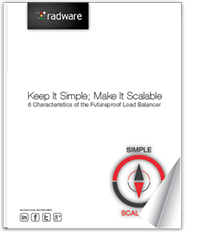The ADC is a Force Multiplier for NFV
The IT industry is moving towards virtualization and software-defined [insert noun here]. IT architects are realize that management and orchestration systems are required to extract the full benefits of the virtualized architectures. The mobile service providers designed network functions virtualization (NFV) as the standard architecture to bring virtualization and cloud-like functionality to their networks.
One of the key challenges with the migration to virtualized functions from proprietary, purpose-built hardware, is the retention of the performance characteristics of the software-based applications. Several instances of the virtual network function (VNF) are required to perform at a level equal to a single instance of a hardware-based appliance.

ADCs scale VNFs
Application delivery controllers (ADC), used as load balancers, are necessary to aggregate these discrete software instances. As aggregation components within the NFV architecture, the ADCs have high performance requirements, event when running as software VNFs, themselves.
Management and orchestration of the virtual infrastructure requires an open and extensible API for the different components to communicate. OpenStack has emerged as one of the leading standards for orchestrating the NFV infrastructure. Unfortunately, OpenStack in a typical virtualized hypervisor environment runs into a significant performance bottleneck due to the virtual switch within the hypervisor’s networking stack.
This is one of the key factors that limits the potential for NFV to succeed and become operational. It is always possible to create enough VNF instances of a function such as a firewall, address translation device, or IMS component, but these VNF instances need to be aggregated through an ADC to meet the performance requirements of these large and complex networks.
[You might also like: Eliminate the Service Roll-Out Bottleneck with NFV]
Optimize the network stack, optimize OpenStack
It is necessary to optimize the ADC VNF instance to meet these performance needs within the virtualized architecture. This must be done without impacting the functionality of the service. For the hypervisor and OpenStack environment, this requires the transparent augmentation and/or replacement of the virtual switch. The modifications must be integrated with the VNF, the ADC, to maximize the performance benefits of the solution.
When augmented ADC VNF with OpenStack is running in an optimal virtual network function infrastructure (VNFI) hypervisor environment, it is possible for the ADC to act as the performance aggregator necessary to operationalize the full benefits of the NFV architecture.
To meet this need, Radware has taken their Alteon NG VA solution, the virtualized and VNF-enabled ADC platform, and partnered with 6WIND to incorporate their Virtual Accelerator to maximize the ADC performance potential while running in a virtualized OpenStack environment. To date, the partnership has been able to achieve 20Gbps per virtual instance without the need to Linux application modifications. One can read the press release here. Radware will be at NFV World Congress in San Jose April 19-22 at booth 39 where you can hear more about this exciting development and more.




